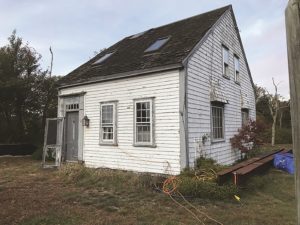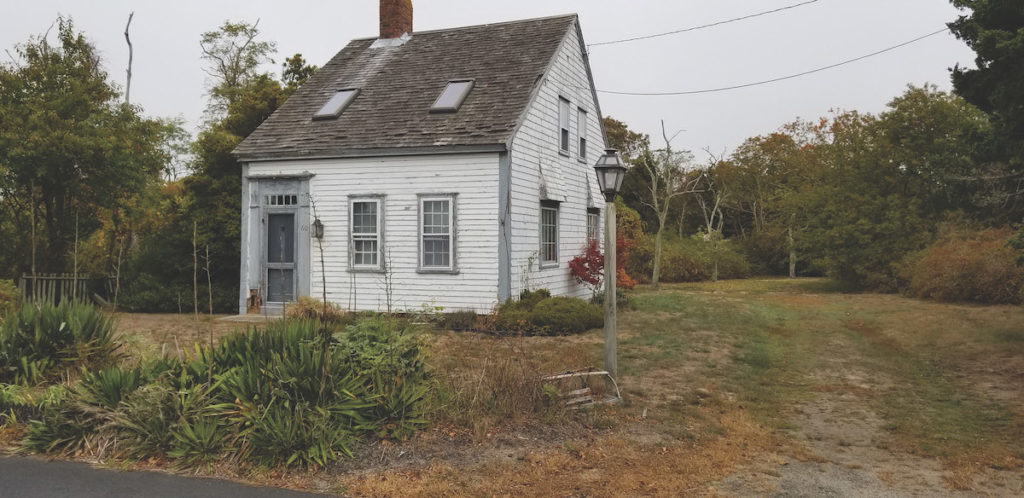EASTHAM — The owners of a historic Sears, Roebuck and Co. Craftsman house on Nan’s Way recently demolished their bayside cottage without permission.
The 787-square-foot home was built in 1936, and the town’s demolition delay bylaw applies to any house more than 75 years old. The bylaw stipulates that the Eastham Historical Commission must review any request to demolish one of these buildings.
Second-home owners Scott and Angela Fillion of Granby had been planning to renovate the house and build an addition of 301 square feet, according to building dept. documents.
Eastham Building Commissioner Justin Post granted a building permit after their builder, Reliant Construction Inc. of North Eastham, applied for one on Jan. 25. Once Reliant’s crew began work, they concluded that the building was a total loss and decided to tear the whole structure down.
Post said that the builders called him from the site to ask for permission to demolish the house after it was already half gone. He agreed. Then Post issued a stop-work order after he realized the house had not gone through the required historical review. But the house had already been razed.
Town Planner Paul Lagg said that, ultimately, the duty to get the commission’s approval is the owners’.
“There was a regulatory oversight, but the applicant had a condition requiring historic review and they didn’t follow the paperwork,” Lagg said.
According to the Eastham Demolition Delay Bylaw, individuals who demolish a “significant” historical building in violation of the bylaw cannot be granted a building permit on the same premises for two years. The historical review process would have determined whether this building was significant.

Penalties for violations of the bylaw include a $500 fine, and each day of noncompliance is a separate offense, the bylaw states. Lagg said he did not know whether those penalties would apply in this situation.
Scott Fillion declined to comment when reached by phone.
“It’s a real tragedy that this happened,” said J. Holden Camp Jr., chair of the Eastham Historical Commission. “One of the conditions for remodeling was that the house had to have a review if it couldn’t be restored. They didn’t have a right to tear it down until there was a review.”
Camp said he could not remember another home owner violating the review requirement.
When the planning board approved the Fillions’ site plan at their Nov. 17 meeting, Art Autorino, a select board member, brought up the need for a historical review and it subsequently became a condition for demolition. Angela Fillion attended the meeting via Zoom, while her attorney, Ben Zehnder, was there in person.
If a historical review had happened, the commission would have employed the help of a historian to photograph the house and document its architectural and historical details. Eastham has more than 800 such entries on the Mass. Historical Commission website. The group would have also hired an expert to check for insect and termite damage before the house was gutted to determine whether the house or any of its elements could be preserved. Then, at a public hearing, the commission would either allow demolition or delay it for one year.
Camp said that the matter is now out of the commission’s hands.
“It doesn’t make sense to have a historical review of a house that doesn’t exist, as far as I can see,” he remarked at the Feb. 15 commission meeting.
“As a matter of curiosity, would you have fought to save a Craftsman house,” asked member Jeff Bumby.
“We would have to go look at it, and we simply can’t look at it,” replied Camp.
From 1908 to 1940, Sears, Roebuck and Co. sold roughly 70,000 home building kits and shipped them across the country. The commission has documented other Sears Midwestern-style Craftsman houses in town, but the house formerly standing at 3 Nan’s Way was done in the beach cottage style. “I don’t know how many of them we have,” Camp said at the Feb. 15 meeting.
Post will soon conduct another review of the Fillions’ plans and issue a revised zoning determination.
“That will dictate regulatory approval going forward, so that may or may not mean zoning board review, planning board review, and resolution on the historical commission situation,” Lagg said. “We’re trying to rectify the situation and have it go back through the proper regulatory channel.”


